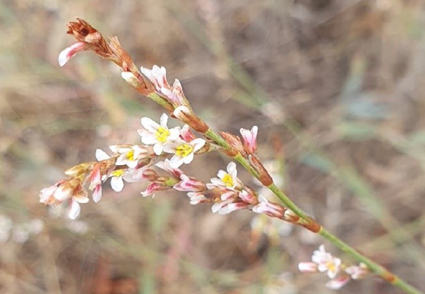Abstract
Polygonum elazigense (Polygonaceae) is described as a new species from eastern of Türkiye. It is similar to Polygonum luzuloides from which differs being much thicker, and by its lignified lower parts and multi-branched stem, as well as leaf and fruit structures and a height exceeding 1 m. In addition to the ecology of P. elazigense, IUCN conservation status, distribution map (including related species) are also given.
References
- Balos, M.M., Sonay, V., Çeçen, C. & Akan, H. (2023) Allium murat-sonayii (Amaryllidaceae), a new species from Türkiye. Phytotaxa 600 (1): 43–51. https://doi.org/10.11646/phytotaxa.600.1.6
- Behçet, L. & Gülbasan, İ.H. (2024) A New Gigantic Vicia (Perennial Wild Vetch) (Fabaceae) Taxon From Eastern Anatolia, Türkiye. KSU Journal of Agricultral and Natural 27 (2): 325–332. https://doi.org/10.18016/ksutarimdoga.vi.1357140
- Behçet, L. & Gülbasan, İ.H. (2025) Allium karakocanense (Amaryllidaceae; Allium sect. Allium), a new species from eastern Anatolia (Türkiye). Phytotaxa 691 (3): 282–292. https://doi.org/10.11646/phytotaxa.691.3.5
- Coode, M.J.E. & Cullen, J. (1966) Polygonum L. In: Davis, P.H. (Ed.) Flora of Turkey and the East Aegean islands, vol. 2. Edinburgh University Press, Edinburgh, pp. 269–280.
- Coşkunçelebi, K., Kundakçı, S., Gültepe, M. & Makbul, S. (2024) A new species of Polygonum sect. Polygonum (Polygonaceae) from southwest of Türkiye. Turkish Journal of Botany 48 (6): 338–350. https://doi.org/10.55730/1300-008X.2821
- Danser, B.H. (1927) Polygonum-vegetaties in de tropen. De Tropische Natuur 16 (2): 28–35.
- IUCN (2025) Red List Guidance Documents- IUCN standards and Petitions Committee. Guidelines for Using the IUCN Red List Categories and Criteria. Version 2022. 15.1. Prepared by the Standards and Petitions Committee. Available from: https://www.iucnredlist.org/documents/RedListGuidelines.pdf (accessed 21 November 2024)
- JSTOR (2025) JSTOR. Available from: https://plants.jstor.org/search?filter=name&so=ps_group_by_genus_species+asc&Query=Polygonum+luzuloides (accessed 22 March 2025)
- Keskin, M. & Severoğlu, Z. (2023) Distribution of Polygonaceae family in Türkiye. International Journal of Agriculture, Forestry and Life Sciences 7 (1): 1–5.
- Komarov, V.L. (1970) Polygonum L. In: Komarov, V.L. (Ed.) Flora of the USSR, vol. 5. (Translated from Russian): Israel Program for Scientific Translation, Jerusalem, pp. 457–536.
- Makbul, S., Kundakçı, S., Gültepe, M., Güzel, M.E. & Coşkunçelebi, K. (2023) Polygonum terzioglui sp. nov. (Polygonaceae), from Northeast Türkiye. Phytotaxa 625 (3): 248–264. https://doi.org/10.11646/phytotaxa.625.3.2
- Menemen, Y., Kandemir, A. & Aytaç, Z. (2016) Türkçe Bilimsel Bitki Adları Yönergesi. Bağbahçe Bilim Dergisi 3 (3): 1–3.
- Mozaffarian, V. (2012) A revision of Polygonum L. sensu lato (Polygonaceae) in Iran. Iranian Journal of Botany 18 (2): 159–174.
- Özhatay, E. (2000) Polygonum L. In: Guner, A., ozhatay, N., Ekim, T. & Baser, K.H.C. (Eds.) Flora of Turkey and the east Aegean islands, vol. 11. Edinburgh University Press, Edinburgh, pp. 54–56.
- POWO (2025) Plants of the World Online. Available from: http://www.plantsoftheworldonline.org/ (accessed 20 March 2025)
- Reichenbach, H.G.L. (1832) Flora Germanica Excursoria, vol. 1. Carolm Cnobloch, Lipsiae, 878 pp.
- Rechinger, K.H. & Schiman-Czeika, M. (1968) Polygonaceae. In: Rechinger, K.H. (Ed.) Flora Iranica, vol. 56. Akademische Druck-U. Verlagsantalt, Graz, pp. 1–88.
- Sanchez, I. & Kron, K.A. (2008) Phylogenetics of Polygonaceae with an account on the evolution of Eriogonoideae. Systematic Botany 33 (1): 87–96. https://doi.org/10.1600/036364408783887456
- Sonay, V., Teksen, M., Balos, M.M. & Yıldırım, H. (2022) Fritillaria karakocanensis (Liliaceae), a new species of the F. crassifolia group from Anatolia (Türkiye). Nordic Journal of Botany 39 (4): 1–7.
- Steward, A.N. (1930) The Polygonaceae of Eastern Asia. Contributions from the Gray Herbarium of Harvard University 5 (88): 1–129. https://doi.org/10.5962/p.336124
- Thiers, B. (2025 [contonuously updated]) Index herbariorum: a global directory of public herbaria and associated staff. New York Botanical Garden. Available from: http://sweetgum.nybg.org/ih/ (accessed 20 March 2025)
- Webb, D.A. & Chater, A.O. (1964) Polygonum L. In: Tutin, T.G., Heywood, J.H., Burger, N.A., Valentine, D.H., Walters, S.M. & Webb, D.A. (Eds.) Flora Europaea, vol. 1. Cambridge University Press, Cambridge, pp. 76–80.
- Xu, Z. & Deng, M. (2017) Polygonaceae. In: Identification and Control of Common Weeds: Volume 2. Springer, Dordrecht. https://doi.org/10.1007/978-94-024-1157-7_23


